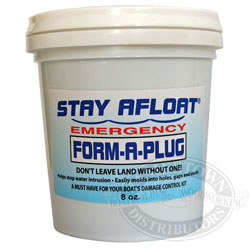

- #STAY AFLOAT EMERGENCY LEAK SEALANT HOW TO#
- #STAY AFLOAT EMERGENCY LEAK SEALANT MANUALS#
Proceed at a low and safe speed if possible, keeping a lookout for obstructions or other watercraft.You'll also want to raise your radar reflector and use the required sound signals. Turn on your LED boat lights and navigational lights.Once you notice a breakdown, it's of the utmost importance that you immediately attempt to repair the issue before it becomes an emergency.
#STAY AFLOAT EMERGENCY LEAK SEALANT MANUALS#
But it's important to always be prepared and ensure your boat is always equipped with spare parts and instruction manuals for every piece of equipment. Or, if you have a lifeboat, quickly prepare it for deployment.Ī regularly well-maintained boat should never experience sudden breakdowns. If you have to abandon the boat, calmly help your passengers into the water.Reach out for help using your marine radio.If this is not possible, use it to at least open up a path of safety for you and your passengers. Aim your fire extinguisher at the base of the flames to try to stop the fire, using a sweeping back-and-forth motion.If the fire is coming from the engine, shut off the fuel supply immediately. What should you do if a fire breaks out in the back of your boat? Head into the wind.

Next, try to position the boat so that the fire is downwind.Immediately stop the watercraft and ensure everyone is properly wearing their life jackets or PFDs in the case that you have to abandon the boat.If a fire does break out on your watercraft, the following steps will help ensure the safety of you and your passengers. It's also not a bad idea to go through this fire drill so that everyone is prepared.
#STAY AFLOAT EMERGENCY LEAK SEALANT HOW TO#
Before setting sail, make sure everyone on board knows where the fire extinguishers are located and how to use them. In the event of a fire, it's also important that you have a working fire extinguisher and fire alarm on board. But there are many flammable materials and fire risks on board that boat owners need to be aware of.
If you're not able to stop the flow of water or reduce it enough to safely transport the boat to a secure location, you'll want to use distress signals to attract attention and prepare to abandon the boat.īoats are incredibly safe if you know how to properly operate and maintain them. This is when hand bailers and electric bilge pumps come in handy. Then, try to empty the boat of as much water as possible by whatever means necessary. Once you've located the source, attempt to stop the leak or minimize the flow of water. Locate the source of the leak, checking the obvious culprits first: drain holes, through-hull fittings, defective bilge pumps, worn outdrive boots, loose engine hoses, etc. There's a reason it's part of most safety drills. First, you always want to be sure you and your passenger are wearing proper life jackets or PFDs. Overall, what should you do if your boat capsizes? You'll want to practice and memorize the following steps: You need to stay focused on getting everyone to safety. As they're sinking, most boats will remain at least partially afloat. So, what should you do first when a vessel capsizes? If your boat is beginning to sink, the situation can be chaotic. Boat owners should be able to calmly and confidently take charge in a situation and help guide passengers to safety. But it's of the utmost importance that, as a boat owner, you know what to do in an emergency. It is often difficult to get people to practice abandoning a boat in the event it capsizes or sinks because most believe they'll never have to actually do it. All boats must have a reboarding device if the freeboard is more than 0.5 meters (1 foot 8 inches).Īs safe as you are and as prepared as you can be, accidents do happen. Then, calmly instruct your overboard passenger to re-board the boat using the attached ladder or swim platform. Once you've shifted the boat's position, make sure you totally turn off the engine. Plus, the wind can actually help blow the overboard passenger toward you. You'll want to then turn the boat and approach the overboard passenger with the watercraft facing upwind, so you can better maneuver the boat and not run over the person. If it's nighttime, ensure they have a flashlight. If you have other passengers on board, assign one of them to keep sight of the person in the water. Next, throw a life ring buoy or lifejacket into the water to help mark the spot and assist the overboard passenger. In the event that someone falls overboard, whoever sees the accident occur needs to shout "Overboard!".






 0 kommentar(er)
0 kommentar(er)
